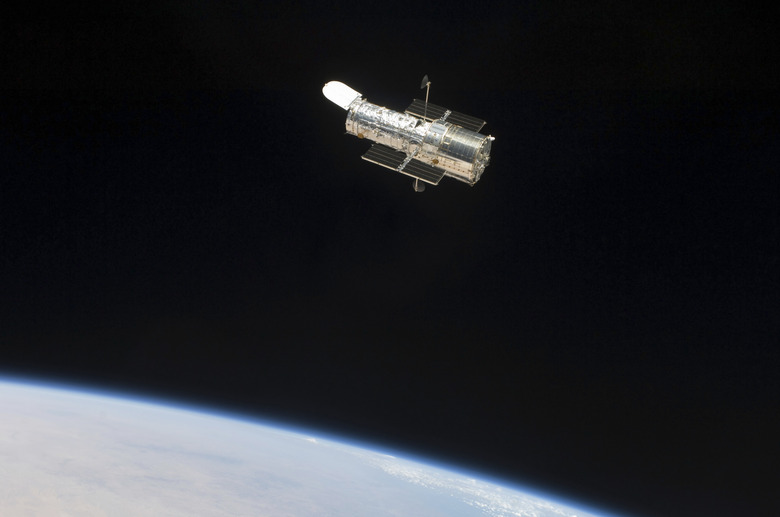Things Found In The Exosphere
Containing only the faintest wisps of hydrogen and other atmospheric gases, the exosphere is the topmost layer of the Earth's atmosphere. It begins at the top of the thermosphere, around 500 kilometers (310 miles), and ends where interplanetary space begins — around 10,000 kilometers (620 miles). In this region of the atmosphere, there's hardly any 'atmosphere': individual particles can travel hundreds of kilometers before bumping into each other, and many of these particles drift off into space. However, at this very moment there are a number of objects floating about on the cold edge of Earth's atmosphere.
TL;DR (Too Long; Didn't Read)
The exosphere is the final and largest of Earth's atmosphere layers, reaching out into outer space. In this frigid region of the atmosphere, actual atmospheric particles are rare — but a number of man-made satellites orbit the Earth. These range from the Hubble Space Telescope to more generic weather and photographic satellites pointed at Earth.
Earth's Atmosphere Layers
Earth's Atmosphere Layers
The Earth's atmosphere is composed of a mixture of gases — which we know as 'air'. But these gases are not spread out evenly across the entire atmosphere, from the surface of the planet into space: instead, the atmosphere thins out as you get closer to outer space, in stages that scientists have categorized into layers. There are five layers, starting with the troposphere, the layer of atmosphere where weather occurs and humans live. The troposphere contains roughly half of the Earth's atmosphere, and is followed by the stratosphere, the mesosphere, the thermosphere, and finally the exosphere, where there are virtually no atmospheric gas particles present. However, gravity still has an effect on objects in this region of the atmosphere — making it well-suited to satellites.
Hubble Space Telescope
Hubble Space Telescope
Without a doubt, the single most well-known object in the exosphere is the Hubble Space Telescope. Launched aboard the space shuttle Discovery in 1990, Hubble orbits Earth at an altitude of around 550 kilometers (342 miles). The telescope has led to numerous scientific discoveries, and according to NASA, the most important have been evidence of black holes and new clues about the age of the universe. Hubble has also found evidence of Earthlike planets orbiting distant stars.
Orbiting Weather Satellites
Orbiting Weather Satellites
A number of weather satellites can also be found orbiting the Earth in the exosphere. Two of NASA's weather satellites, known as Advanced Television Infrared Observation Satellites, circle the planet in an almost north-south fashion — going from pole to pole. Both satellites have a regular, circular orbit — with one crossing the equator at 7:30 a.m. local time, the other crossing at 1:40 p.m. local time. The satellites are constantly gathering atmospheric data and capturing cloud images, allowing scientists to track short-term weather conditions and long-term climate patterns.
NASA Research Satellites
NASA Research Satellites
In addition to weather satellites, NASA has a number of research satellites in the exosphere — such as its Aqua and Interface Region Imaging Spectrograph satellites. At an altitude of 670 kilometers (390 miles), the IRIS satellite's polar orbit allows it to gather heat and energy data from the lower levels of the sun's atmosphere. Aqua orbits the Earth at an altitude of about 710 kilometers (440 miles) — taking around 99 minutes to circle the globe. Its six on-board instruments allow it to gather daily information about the Earth's water cycle.
Satellite Photo Imagery
Satellite Photo Imagery
Several photographic imagery satellites also orbit Earth in the exosphere. Many of these satellites — like IKONOS and QuickBird — are commercial satellites that capture images for public consumption or military uses. IKONOS orbits the Earth at an altitude of over 680 kilometers (420 miles) and can observe the exact same point on Earth once every three days. QuickBird has an orbital altitude of about 450 kilometers (280 miles) — after initially reaching a height of 482 kilometers (about 300 miles) — and can provide both submeter resolution imagery and a high degree of geolocational accuracy.
Cite This Article
MLA
Smith, Brett. "Things Found In The Exosphere" sciencing.com, https://www.sciencing.com/things-found-exosphere-8576571/. 18 October 2018.
APA
Smith, Brett. (2018, October 18). Things Found In The Exosphere. sciencing.com. Retrieved from https://www.sciencing.com/things-found-exosphere-8576571/
Chicago
Smith, Brett. Things Found In The Exosphere last modified August 30, 2022. https://www.sciencing.com/things-found-exosphere-8576571/
